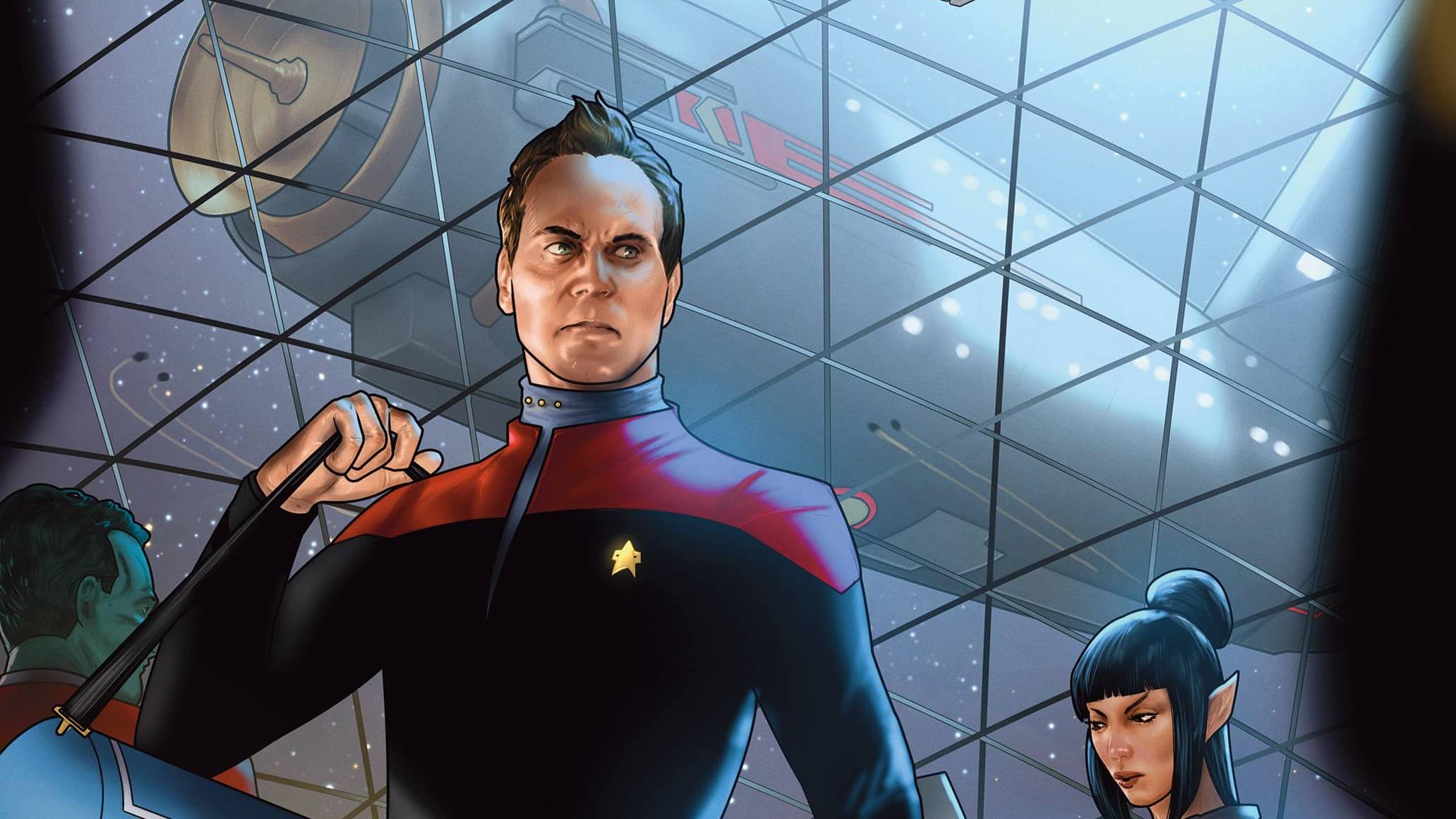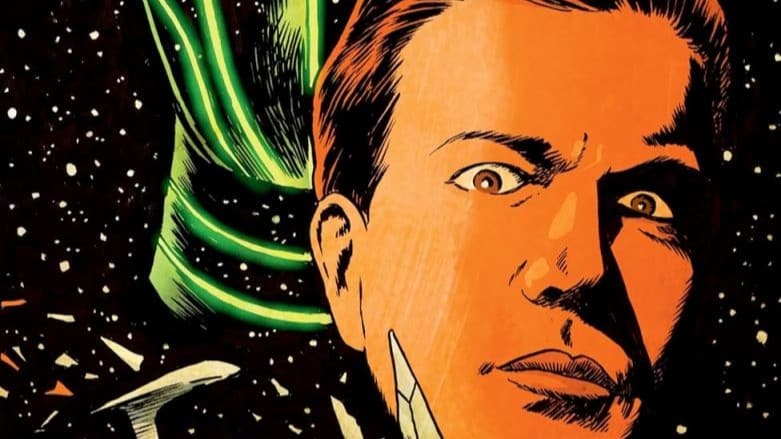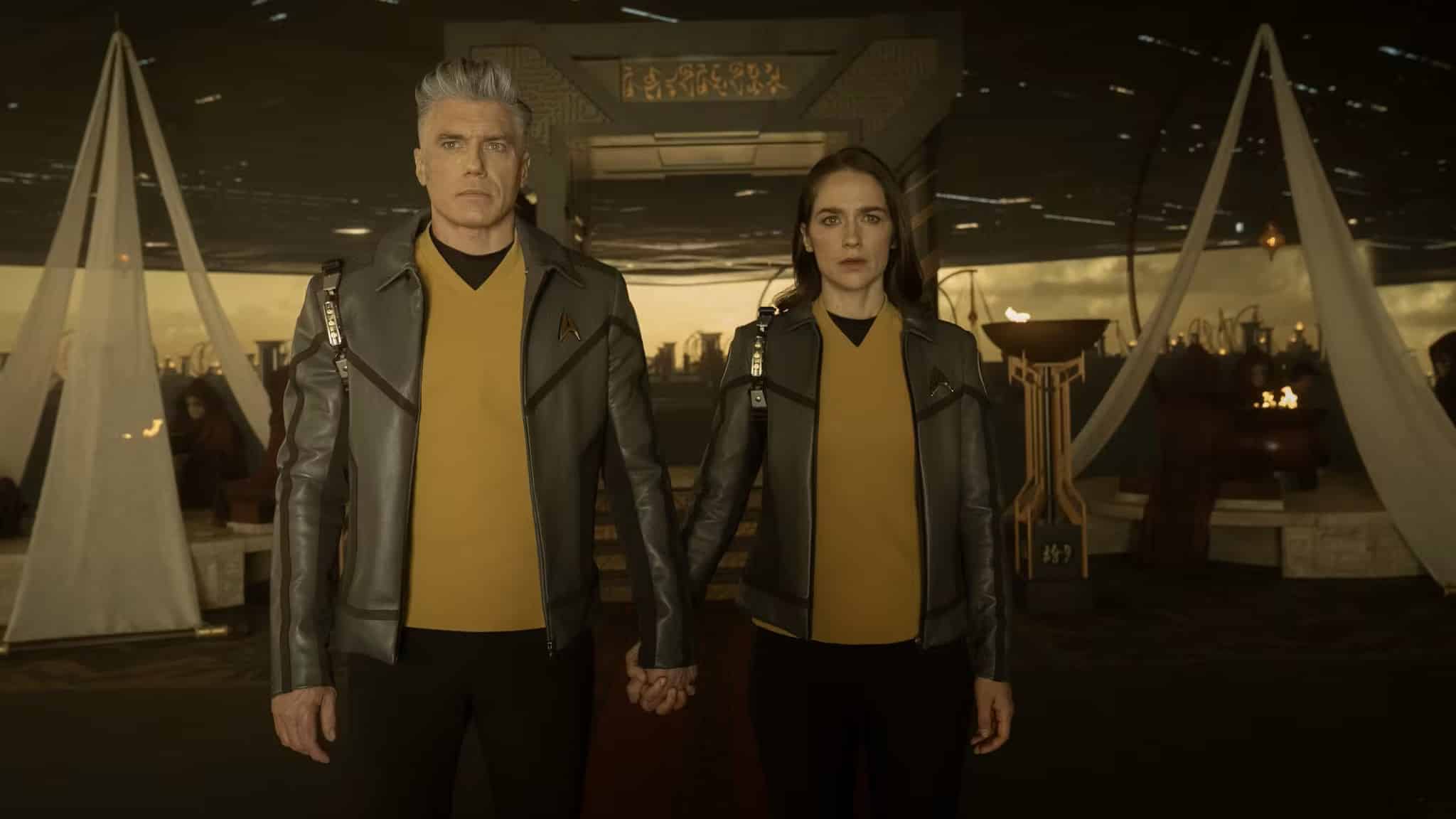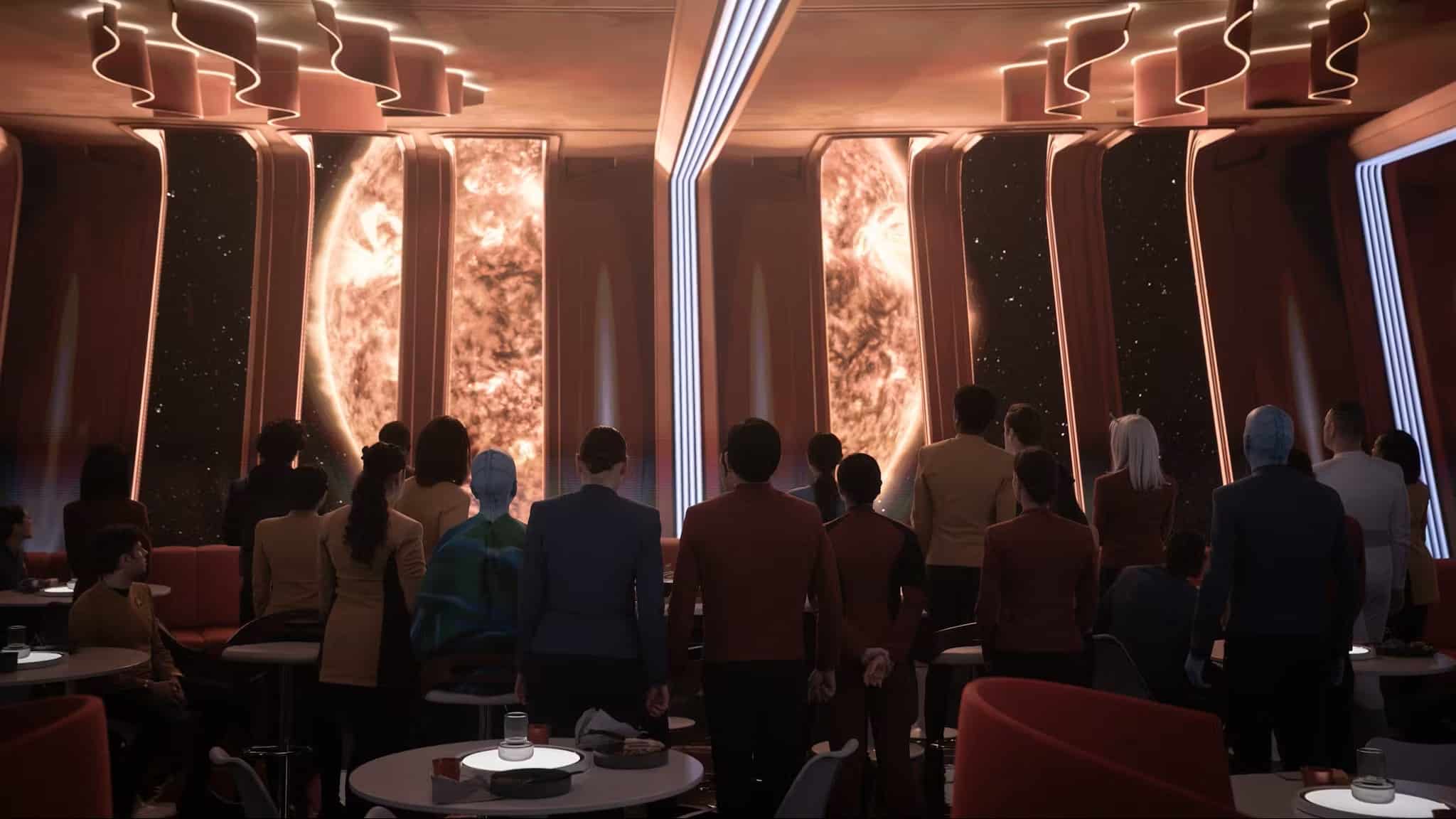Trek Talks is back and covering a pair of stories all about breaking barriers and plumbing the depths of past continuity! Star Trek #20, written by Collin Kelly & Jackson Lanzing with art by Megan Levens, colors by Lee Loughridge and letters by Clayton Cowles. Star Trek: Defiant #15, written by Christopher Cantwell, with art by Ángel Unzueta, colors by Marissa Louise and letters by Clayton Cowles.
Mark Turetsky: Tony? Is that you…? Site… out of danger?
Tony Thornley: Sssssh, it’s all OK now, Mark. The ComicsXF search and rescue team has found you.
Mark: ComicsXF? I should have known! I bet Zack Jenkins himself hauled the old girl out of mothballs to come looking for me. Tell me, how long have I been missing? What year is this?
Are You There, Gods? It’s Me, Sisko

Mark: Excuse me. …I’d just like to ask a question. …What does God need with a guest house? And what’s an appropriate gift to bring God as a houseguest?
Tony: Clearly, CLEARLY, it’s a starship Mark. So what else are we going to do but give them the Theseus?
Mark: We’ve got a great guest character in Star Trek #20, and it’s the breakout star of Picard season 3, Liam Shaw! A character who became so popular that his creator, Terry Matalas, had to hint to fans he’d return if Picard ever got spun out into the fabled Star Trek: Legacy, despite him being dead. One thing that I’m sure took an immense amount of restraint from Kelly and Lanzing: he never says his de facto meme catchword, “No.” Sure, he’s still telling everyone “no,” but never in so few words, and he never even uses the word itself.
Tony: The amount of grouchy Shaw this issue packed in was impressive, and that’s definitely a testament to the strength of this series.
Can I also say how cool it finally is to really truly see Utopia Planitia at work? Every other time we’ve seen it, it’s been glimpses and glances. Here, we fully see the tools and resources of the shipyard at work. While the crew of the Theseus refits the ship, Shaw hovers and grumbles about how its not going to work. We get to see Scotty in his element, though, and it’s great.
And all of this is just to pierce the Galactic Barrier, aka a plot device invented to make Gary Mitchell a god.
Mark: The Galactic Barrier is such a weird concept. It’s almost as old as Trek itself, in that it comes from The Original Series’ second pilot, “Where No Man Has Gone Before.” In that episode, the Enterprise crosses the Barrier and two of its crewmembers, Gary Mitchell and Dr. Elizabeth Dehner, develop superhuman abilities after being zapped by some energy.
Just the idea that our galaxy has a barrier around it is kind of antithetical to what galaxies look like. They’re denser toward the middle and just kinda peter out at the edges. The barrier comes up in a few more TOS episodes and then is never heard from again (though its counterpart, The Great Barrier, a similar barrier in the middle of the galaxy, is a huge part of Star Trek V: The Final Frontier) until Discovery visited it in 2022, where they met Species 10-C, a godlike race that lived just beyond the barrier. The funny thing is, in the cases of both the Galactic Barrier and The Great Barrier, both barriers are associated with godlike beings. So it’s kind of natural that reaching the Pleroma, the home of the gods, would require messing around with the Galactic Barrier.
Tony: The Barrier is one of those plot devices we see too much in fiction — it’s interesting in concept but literally no one has done anything interesting in the execution of it at all.
I think this is one of the best reasons why Expanded Universes are so cool in our modern IP driven world. I look at this line of comics, the current Star Wars: The High Republic material, and some of the really cool video game tie-ins (thinking of Halo but keeping it vague because I know there’s more out there). Each of them takes what’s on the screen and deepens it. It’s even better when they take the toys in the toybox and do something fun and interesting with them. This series and Defiant have largely been doing that — they pick up that large bin of Playmates action figures (seriously, newer fans, they made a figure of EVERYONE), mash them together, then say, “okay, what’s next.”
Just like T’Lir’s true identity.
Mark: I have to admit, I was wrong: T’Lir didn’t turn out to be Trelane. They turned out to be an Organian, one of the godlike entities in the TOS episode “Errand of Mercy.” As an Organian, they appeared as Tandela, the daughter of Ayelborne, the chairman of the Council of Elders (one of the paradoxical things about the Organians is that they claim not to have any figures of authority, and yet the existence of The Council of Elders would seem to imply otherwise. The fact that said council has a chairman also adds to the enigma). Ayelborne has the most lines of any of the Organians in “Errand Of Mercy,” and we never see Tandela, though T’Lir claims that they’ve met Spock. This likely happened during the portion of the episode where Spock wanders off on his own to investigate the Organian culture.
Tony: The only place where this reveal doesn’t work for me is how Spock influenced T’Lir. It sort of lessens the impact of “Spock was such an influence on me” if we have no idea how Spock actually influenced them. Maybe a flashback to that is coming later in the story arc. But otherwise, I liked this quite a bit.
Mark: The device that T’Lir has designed to enter the Pleroma is called the Kardashev drive. The name should be familiar to sci fi fans: the Soviet astronomer Nikolai Kardashev developed the scale in the 1960s, so the concept dates from the same era as Star Trek. It’s a scale for determining the power of a civilization. A civilization of Type I on the Kardashev Scale is one that can harness all of the power emitted by their parent star that reaches their planet. Type II is a civilization that can harness all the power of the star itself (think Dyson sphere). Type III is a civilization that harnesses all the power of their home galaxy (quite a jump between II and III here).
In Star Trek #19, T’Lir calls the Pleroma an “extradimensional location created for a specific purpose by civilizations existing at or above the third Kardashev level.” It’s kind of interesting that T’Lir defines the gods of Trek as existing “at or above” the third level, because it makes little sense for there to be multiple type III civilizations living in the same galaxy. If one of them is harnessing all of the power of the galaxy, where are the other ones getting the same scale of power from? It’s possible that they’re harnessing the same scale of power by some undreamt of exotic means, I suppose.
Tony: Yeah, it’s very much Treknobabble that deepens the story, but honestly is a little bit of nonsense when you look deeper at it. It’s a bit of necessary babble to make the story work, though.
Mark: Before the Theseus gang rushes off to meet their makers, we get a scene between Lily Sato and T’Lir. Lily hasn’t been coping well with, well, anything lately. Her maiming on Tzenketh, along with the seeming betrayal by her closest friend — T’Lir — has left her in a pretty vulnerable state. We see her on the surface of Mars (we’re still a few years out from that planet being re-rendered uninhabitable in the Short Trek “Children of Mars”) when she gets ambushed by T’Lir. T’Lir wants to make up with her, but Lily won’t have it. It’s tough to judge how much of her indignation is feigned for the sake of getting T’Lir to leave so that she can make her illicit meeting unobserved.
The meeting has all the appearance of a drug deal (which, hard to blame Lily for looking to cope with her obvious PTSD; does the Theseus even have a ship’s counselor?), but it’s most likely a meeting with her Section 31 contact. And what else could she be delivering to them but the plans for the Kardashev drive? Just the thought of a secret government organization showing up in the home of the gods should be terrifying, right?
Tony: I don’t know if I ever told you this, but I used to gamemaster a few online Trek RPGs. One of the hallmarks of these “sims” was Section 31 invariably showing up (the other was everyone did a Borg story). Few players and GMs could properly handle the nuance of Section 31, because they wanted to just have the shocker of it.
That’s a long way of saying Section 31 should be a long game. If you’re going to use them, build them up over time, use them sparingly, tease out what they’re doing. I think that’s exactly Lanzing and Kelly’s plan. So yeah, will they show up next issue in the Pleroma suddenly? I don’t think so. But will this come back? Yeah, definitely.
Mark: The trip into the Pleroma is, well, a trip! It’s conceptually similar to the “Jupiter and Beyond The Infinite” segment of 2001: A Space Odyssey (which Commander Shaw references earlier in the issue, calling them monkeys trying to build the monolith) as well as the sequence it inspired in Star Trek: The Motion Picture, and it’s a visual delight. The liberal splashes of psychedelic colors, the bridge crew appearing as floating heads trailing squiddly tentacles, the Theseus appearing as a biblically accurate seraph.
Tony: Also, hilariously, Tom Paris has Miral in a baby carrier strapped to his chest. So we get an adorable part-Klingon baby going through this whole thing with the crew. A great sight gag that artist Megan Levens nails.
Mark: Once they reach the Pleroma, we see an array of the different godlike beings who live there, arranged along the lines of a golden spiral. From what I can figure out at a glance, we’ve got The Guardian of Forever, The Caretaker (from Voyager), the nice manor house which might be Trelane’s house, or possibly an Organian house. On the bottom row, the only one I can make out is Apollo’s temple from “Who Mourns For Adonais?”
Tony: The other maybe I see is the castle on the bottom row that MIGHT have something to do with Q, given Qpid and his general predisposition for the grandiose.
Mark: We also get what for me was the most exciting reveal: Kore Soong from Picard’s second season. For those of you who haven’t seen it, Kore was the daughter of the Adam Soong (well, a clone of his daughter, at least), an ancestor of Dr. Noonien Soong, Data’s creator. In the final episode of the season, she’s approached by Wesley Crusher who recruits her to be a Traveler. Unfortunately, that thread got abandoned in Picard’s final season, which ditched most of the series’ cast and instead focused on Next Generation nostalgia, for better or worse. Anyway, Kelly and Lanzing have chosen to pick up that abandoned thread here, as she’s now a representative of Aegis. Aegis is the non-canon name given to the organization that Gary Seven (from TOS: “Assignment Earth”) and Talinn (from Picard season 2) belong to.
Tony: An organization which, notably, was a HUGE part of Lanzing and Kelly’s Star Trek Year Five, a series that keeps, rightfully, getting referenced in this series. A connection between the Travelers and Aegis makes tons of sense to me.
Past the Horizon of Events

Mark: So we move from a book that asks big questions, like “how would we interact with aliens who are like unto gods in an ethical framework that prizes science and reason?” to asking smaller, more awesome questions like, “What would happen if Spock mind melded a parasite alien?” or “what if there were only two Borgs in a collective? And what if someone in that collective had a parasite alien?”
Tony: This story arc is packing in so much. Now, since this is our first time back since the middle of the last arc of each series, it’s important to point this out.
This story arc is a direct sequel to one of the ultimate unresolved storylines in Trek history: “Conspiracy.” That’s the episode that revealed that alien parasites had infiltrated Starfleet and the Federation, yet was never followed up on again. So, thirty years later, here’s the resolution.
Mark: Star Trek Defiant #15 starts with a flashback to Nymira’s rock bottom. She’s a junkie hanging out in a hive of scum and villainy (seriously, this place is just straight-up the Mos Eisley cantina, right down to guys getting blasted in the booths for messing up a smuggling deal).
Tony: Given that Nymira really does appear to be a totally new character, I appreciate this more and more. She needs a back story to go with it, and an Orion medic who struggles with addiction is a hell of a back story.
Mark: The revelation that the parasites come from another dimension makes a lot of sense: it explains why we haven’t heard back from them in any of the shows or movies (though evidently that was considered for the final season of Picard). Having them be an invasive species from a neighboring dimension clears that up, and also puts the story into more of a horror space, reminiscent of the movie Event Horizon.
Tony: And given that Cantwell has straight up cited Event Horizon as an influence, it makes sense. We didn’t get a chance to talk about it, but there’s been some serious body horror in the last few issues, and Defiant #15 just ramps it up. For a story that’s kind of going around cleaning up past continuity, it’s a hell of a story.
Mark: When all seems lost, we get our Sela ex Machina. We’ve known for a while that this moment was coming. It’s helpfully telegraphed on the cover, which has been in the comic’s solicitations since February. Just to put things in perspective, the excellent Defiant annual featuring Sela breaking away from the Romulans came out about a month earlier, in January, so it was not hard to see the arc of her story. I’m just glad she’s here now, as she’s an excellent addition to the gang, not to mention being well-written.
Tony: I mean, we lost Lore at the end of “Day of Blood” too, so Sela returning to become a full time cast member (presumably) is a welcome addition. She’ll be fun to see play off the crew more and more.
Mark: There’s a really odd sequence about halfway through the issue. The page becomes an action montage of the Defiant gang fighting through waves of possessed Starbase crew. The complete text of the poem “Black riders came from the sea.” (technically untitled, but referred to by its first verse) gets retold in the captions for the page. The text comes from Stephen Crane, the author of The Red Badge of Courage. The book that it comes from, The Black Riders And Other Lines deals with themes of Crane’s struggling with his own doubts about belief in God.
The riders themselves are abstracted down to the motion of things outside of their bodies: the hooves of their horses, the steel of their swords, their shouts (okay, hair is a part of their body, but it’s in a liminal space), while their victims are completely absent from the text. We never get any idea of who they’re attacking, the fear that they feel, the death that’s being meted out to them. The imagery focuses on the exhilaration of the riders, and the final line tells you that that violence, that pulpy action about the greatness of war, that’s sin. This is actually hell, and it’s wrong to take pleasure from it.
Stylistically, Star Trek has always had pretentions to highbrow status (they’re always acting out Shakespeare plays or having string recitals on the Enterprise), but I don’t think we’ve ever gone quite as far as having a battle scene and putting an unconnected voice reciting a poem over it. It’s ambitious, but I don’t think it quite works here.
Tony: For me it was nothing but a bit of an eerie moment, but all of this story is a bit eerie. It was an interesting bit of color. That’s about it.
But then, we get the partially possessed Spock, standing in the dimensional gateway. And while I don’t think it’s quite as horrifying as Cantwell meant for it to be, it worked. A Spock not in the full possession of his faculties is always a bad thing.
A Few More Bits of Data
- Paris and Torres continue to compete for worst parent in Starfleet (giving Worf a run for his money). I’m half-certain that Miral’s presence in the Pleroma is going to save the day. Something about the infinite potential of a baby being coupled to the presence of godlike aliens. Like Shogo visiting Otherworld in the X-Men comics.
- The bartender at the cantina is a Xindi-Reptilian, who were last seen in the 2022 Star Trek: Prodigy episode “Crossroads.”
- For an issue in which Torres is assimilated the entire time, it’s surprising there’s not a single reference to the last time she was. True, none of the rest of the cast definitely knows that (though I might have missed a reference to it last issue), but you’d think they’d find a way to work it in.
- That said, assimilated Torres is sure creepy.
- Considering Section 31 at some point ends up in possession of all the Soong androids in order to make the Data Golem from season 3 of Picard, we might see a connection Section 31 and Lore coming up, since Lore is still very much a wild card in these series.
- When I say the Playmates Trek action figure line was large, I mean, like, Star Wars-level big. Just go look up a random character that debuted before the end of DS9 and look for an action figure of them. Guarantee you’ll find one.







